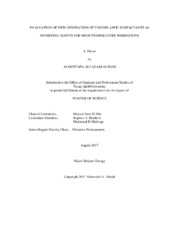| dc.contributor.advisor | Nasr-El-Din, Hisham | |
| dc.creator | Alhadi, Almostafa Ali Adam | |
| dc.date.accessioned | 2018-02-05T21:15:03Z | |
| dc.date.available | 2019-08-01T06:51:59Z | |
| dc.date.created | 2017-08 | |
| dc.date.issued | 2017-07-31 | |
| dc.date.submitted | August 2017 | |
| dc.identifier.uri | https://hdl.handle.net/1969.1/165884 | |
| dc.description.abstract | The viscoelastic surfactant (VES) is one of the newest chemicals that have been used as diverting agents to divert the acid to the desirable zones through directing the acid to the lowest permeability formations by building in-situ viscosity. This technique shows valuable properties in diverting and cleaning processes. However, the main problem associated with this technique is a temperature limitation; therefore, the research is continuing developing new chemicals that overcome the high-temperature short come.
This study aims to evaluate the rheological properties of five new types of the VES that are proposed to be used in oil industry through conducting the lab tests on this new generation of the VES. The spent acid system which contains 6 vol% VES was prepared and the PH was adjusted between 4 and 5 while the pressure was maintained at 400 psi.
The different types showed various performances in different conditions, VES001 showed high viscosity around 100 cp at a shear rate of 10 s-1 and temperature of 2000F. while VES002 didn’t show any viscosity building in high temperatures (200 and 2500F). VES003 and VES004 showed a high viscosity building around120 cp in temperature of 2500F at a shear rate of 10 s-1. Type 5 showed promising properties in high temperatures since it showed viscosity of 120 and 220 cp in 200 and 2500F, respectively. Moreover, its viscosity didn’t peak even at 3700F when it showed viscosity of 550 Cp at a shear rate of 87s-1.
Further tests were obtained on the VES005 to deeply evaluate both its capability as diverting agent and its compatibility with the other acid additives. The effects of several corrosion inhibitors on the performance of the VES were studied then the optimal inhibitor was used for the further studies. Core-flood tests were conducted to emulate the performance of the system inside the formations. Two types of Indiana limestone cores, 150 mD and 12 mD, were used. The exciting diverting performance was observed through the low permeability core; however, some diverting performances were observed in the high permeability core. CT scan was used to reinforce these results. | en |
| dc.format.mimetype | application/pdf | |
| dc.language.iso | en | |
| dc.subject | viscoelastic surfactant | en |
| dc.subject | acidizing | en |
| dc.subject | rheological properties | en |
| dc.subject | matrix acidizing | en |
| dc.subject | diverting agents | en |
| dc.title | Evaluation of New Generation of Viscoelastic Surfactants as Diverting Agents for High-Temperature Formations | en |
| dc.type | Thesis | en |
| thesis.degree.department | Petroleum Engineering | en |
| thesis.degree.discipline | Energy | en |
| thesis.degree.grantor | Texas A & M University | en |
| thesis.degree.name | Master of Science | en |
| thesis.degree.level | Masters | en |
| dc.contributor.committeeMember | Holditch, Stephen | |
| dc.contributor.committeeMember | El-Halwagi, Mahmoud | |
| dc.type.material | text | en |
| dc.date.updated | 2018-02-05T21:15:03Z | |
| local.embargo.terms | 2019-08-01 | |
| local.etdauthor.orcid | 0000-0002-9740-0232 | |


